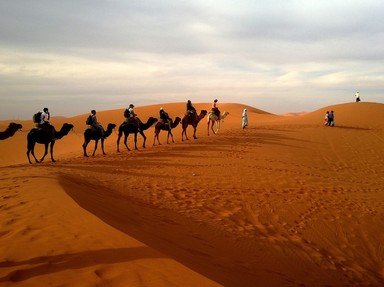Quiz Answer Key and Fun Facts
1. Located in the Afar Depression in Eastern Africa, the Danakil Desert contains some of the lowest points on Earth. What body of water does it border?
2. In which large peninsula would you find the desert whose name translates into English as "Empty Quarter"?
3. What nickname, reminiscent of something you might eat for breakfast, is given to the hottest part of Iran's Dasht-e Lut desert?
4. One of the world's largest subtropical deserts, the Thar Desert forms a natural boundary between which two densely populated Asian countries?
5. For many centuries, caravans travelling on the Silk Road crossed the harsh Taklamakan Desert, located in which autonomous region of northwest China - home to the Uyghurs, a largely Muslim ethnic group?
6. Much of Australia's territory is covered by deserts or semi-deserts. What of these facts about the Great Victoria Desert is NOT true?
7. The US's northernmost desert, the Great Basin Desert touches a number of Western states. Which of these is the odd one out?
8. Though characterized as a cold winter desert, most of the the Patagonian Desert consists of what kind of biome - associated with large parts of Eastern Europe and Central Asia?
9. Stretching for hundreds of miles along the coast of southwestern Africa, the Namib Desert is believed to be the world's oldest desert. What weather phenomenon, very hazardous to navigation, frequently occurs there?
10. Europe's only true desert, the Tabernas Desert is found near the city of Almeria in which country?
Source: Author
LadyNym
This quiz was reviewed by FunTrivia editor
agony before going online.
Any errors found in FunTrivia content are routinely corrected through our feedback system.
